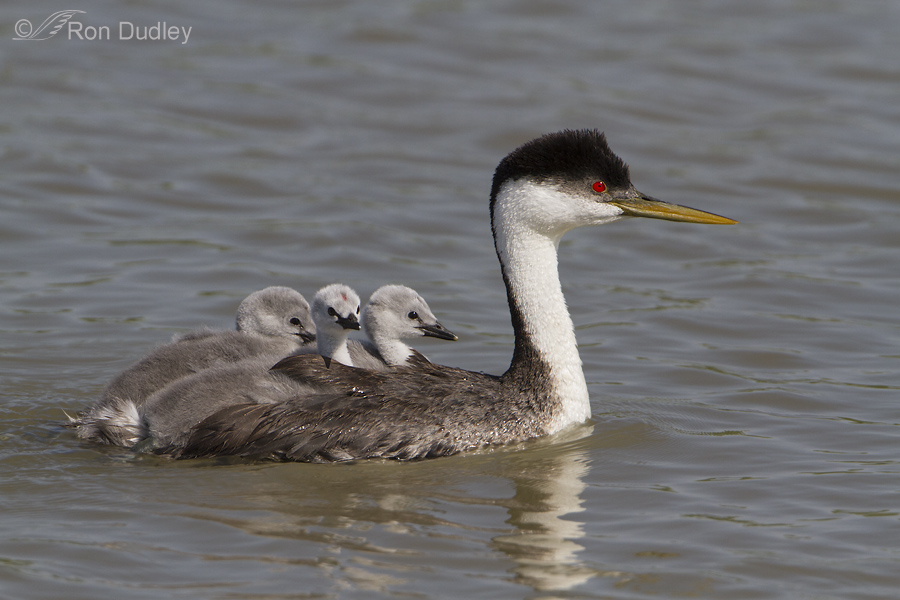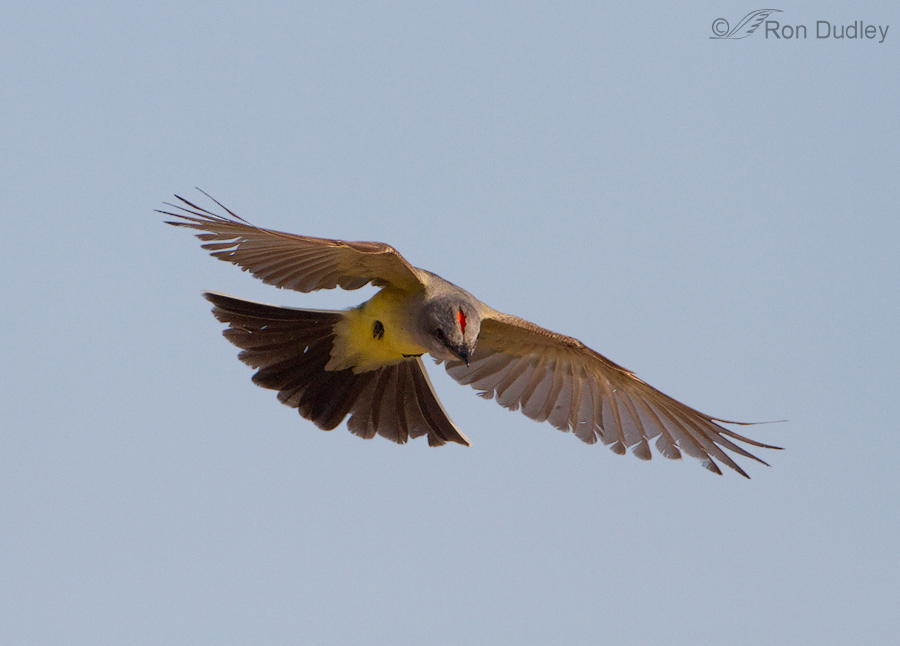A trio of Western Grebe chicks on the back of a parent can certainly be eye-catching. And in this case they piqued my curiosity.

1/2500, f/8, ISO 500, Canon 7D, 500 f/4, 1.4 tc, not baited, set up or called in
I photographed this family of grebes two summers ago at Bear River Migratory Bird Refuge. At this stage the chicks are fat, long-bodied and often rambunctious and it’s a wonder that there’s room for all three up there. Here they’re waiting for the other parent to bring them a fish (this image is full frame and a little tight).
Occasionally I’ve noticed the chicks flash a red patch in the middle of the forehead. Usually it can’t be seen but it’s quite apparent in the middle chick, above. I suspect its purpose is to communicate something to other birds – its parents, its siblings or perhaps both but I’ve never noticed a relationship between it being flashed and a particular behavior. So I did a little research but found very little and what I did find was conflicting. One source said the patch was flashed during begging behavior while another said the “nestlings have a bare yellow head patch that turns crimson when under stress”. Perhaps the competition often involved with begging is stressful and both sources are correct – I just don’t know.
A colored crown patch that is usually hidden but revealed in certain situations as a communication tool is also found in a few other species – some kinglets and kingbirds for example. The Western Kingbird has a red crown patch that it reveals during aggressive displays toward other kingbirds during the breeding season or when it’s acting aggressively toward other species (which kingbirds often do, thus the name). This kingbird was threatening a gull perched on a pavilion very near the its nest.
To my knowledge most birds with hidden, colored crown patches that are revealed for display purposes are adults so I was interested that in Western (and presumably Clark’s) Grebes the patches are apparently only present in the chicks.
Ron



Ron,
2 years ago I took a multiweek project in shooting both dancing grebes at Klamath falls as well as feeding the chick stage. As per your post, I went back and looked at all my shots to try to see if there was a red patch. I came up with none like yours. Interesting. And my feeding shots, the chicks were about the same size as this shot.
An aside – in April, I will be coming south (from Oregon) and spending about 3 days at Antelope and Farmington and Bear River on my way to Arches/Canyonlands. After all your work, I will be intrigued to see how shooting there really works. When you shoot out of your truck, do you have another specialized tripod on your window or beanbag? I find that in my Subaru Outback, trying to shoot out the window I am always crunched for space and my retrofitted hard foam placement on the 500mm sometimes doesn’t work well.
Love your work (my first degree was in zoology and I love the behavior aspect as well.) Happy Exploring – Barb
Barb, like Western Kingbirds I think the grebe crown patch is only visible when the feathers on the top of the head are erected.
I gave up on beanbags and window tripods long ago. For years now I’ve used a “Noodle” on my window and couldn’t be happier with it. See this post.
https://www.featheredphotography.com/blog/2010/08/19/how-i-photograph-birds-3/
yup, like your noodle I have used a hard cell foam (but rectangular) piece with a slit in it (for the glass) -( like yours)-that was made for kayak hauling – same idea,but I can see the advantage of round. but yes, I have gotten wear marks on the lens cover. I like the contraption for shooting out of the right window. at 5″0″ I still have trouble shooting out my window, maybe I will try pillows, etc to get me up higher and thus better able to manage shooting out of the window – I had seen one of your posts re: the mid cab holding device, but not this particular post. you certainly have been creative re: your back issues and still being able to shoot. thanks
Great shots of these patches, forgot about the kingbird, don’t always get to see that angle.
Thank you, Jane.
Great photos Ron. I never knew about the red patch on the Kingbirds. I will keep an eye out for them this summer when they return. I appreciate getting to see your photos and for the educational aspect of your blog too. Thanks !
Thank you Ed, particularly for the part of your comment about the “educational aspect” of my blog.
What a sweet picture of the Grebe’s. Also love the Kingbird in flight. I learned something today. We have both type of birds in our area, and I have never seen the red patch. Interesting, and colorful!
You weren’t alone, Jean – lots of folks are unaware of the red patch in either species. As was I for a very long time.
When red is associated with the feeding response, isn’t it usually in the beak area of the parent bird? Is it ever anywhere else?
Patty, I thought it was usually in the mouth lining of the chicks…
I guess I was thinking of gulls…there’s a red spot on the (gray?) gulls beak the young ones seem to respond to. !aybe that’s only with a particular kind of gull.
How amazing. The youngsters I see rely on their far from melodious voices to let the parents know that they need attention. NOW. NOW I SAID. DIDN’T YOU HEAR ME!!!! NOOOOOW.
A colour flash is so much less stressful for the onlookers…
Baby grebes are really cute, but I wonder if their parents ever get sick of lugging them around. Do both parents do this? I counted 3 heads, but it looks like an extra, gray, fuzzy body (but no head ) in front of the others. Is that possible? Very interesting info re: head patches. If I’d seen the red one, I’d have thought it was an injury…glad it’s not.
Patty, I believe there’s only 3 chicks here. Yes, both parents back-brood. They take turns and when one gets tired of parental duty it unceremoniously and very deliberately dumps the chicks into the water – it’s hilarious to watch. Photos of that happening in this link if you’re interested. https://www.featheredphotography.com/blog/2012/06/15/western-grebes-dumping-their-chicks/
I think what I thought was the back of another chick, actually goes with the middle chick head. Thanks for answering.
I did check put the link…and recognized …funny!
What wonderful shots and interesting commentary!
Charlotte
Thank you, Charlotte.
I read that in some species, the red seen has to do with a feeding response.
Interesting, Rich. Thanks.
Beautiful shots and great info. I had no idea that the chicks had this, and the pic of the kingbird is spectacular! Thank you for brightening my morning on this cold winter day.
Tana, yes, it is gloomy around here but this morning does look a bit more promising, doesn’t it. Glad you like the kingbird shot – that’s one I’d been after for a while (showing the crown patch in flight).
Great shot Ron, and interesting post. I will be interested what others come up with as the evolutionary reason? for the yellow turning to red patch on a chicks head. However, I like your second possibility.
Thanks, Dick. Interestingly, I’ve never seen the yellow color in the patch.
What an elegant evolution to help parents of large broods detect who needs attention the most!
Yes, well said, Alison.